A Client Has A Fracture Of The Tibia, And A Cast Is Applied. Which Action Will The Nurse Take?
This is a quiz that contains NCLEX review questions for bone fractures. As a nurse providing care to a patient with a fracture, it is important to know the signs and symptoms, nursing management for casts and traction, complications, patient education, and treatment for this condition.
In the previous NCLEX review series, I explained about other musculoskeletal disorders you may be asked about on the NCLEX exam, so be sure to check out those reviews and quizzes as well.
Don't forget to watch the bone fractures lecture before taking the quiz.

Fractures NCLEX Questions
This quiz will test your nursing knowledge on fractures in preparation for the NCLEX exam.
(NOTE: When you hit submit, it will refresh this same page. Scroll down to see your results.)
Fractures NCLEX Questions
1. Figure 1 represents what type of bone fracture: This is a fracture that is slanted across the bone shaft.
A. Transverse Fracture
B. Spiral Fracture
C. Oblique Fracture
D. Compound Fracture
The answer is C. This is known as an oblique fracture.
2. Figure 2 represents what type of bone fracture: The fractured bone is broken into many fragments (3 or more).
A. Open Fracture
B. Greenstick Fracture
C. Oblique Fracture
D. Comminuted Fracture
The answer is D. This is known as a comminuted fracture
3. Figure 3 represents what type of bone fracture: This a fractured bone that breaks through the skin.
A. Closed Fracture
B. Compound Fracture
C. Greenstick Fracture
D. Transverse Fracture
The answer is B. This is known as a compound fracture (also called an open fracture).
4. You're caring for a patient who has experienced a fracture to the right arm that is represented in Figure 3. What nursing intervention will you take with this type of fracture?
A. Cover the fracture with a sterile dressing
B. Place the arm below the heart level.
C. Attempt bone reduction by manually readjusting the bone.
D. Place a tight compression bandage over the fracture.
The answer is A. Figure 3 represents a compound fracture (also called an open fracture). Due to the nature of this fracture, the patient is at major risk for infection because the skin is no longer intact. Therefore, the nurse should cover the fracture site with a sterile dressing. NEVER attempt a bone reduction. In addition, avoid a tight compression bandage due to the development of ischemia. Instead, you would want to immobilize the extremities and splint it.
5. A 85 year old patient has an accidental fall while going to the bathroom without assistance. It appears the patient has sustained a bone fracture to the left leg. The leg's shape is deformed and the patient is unable to move it. The patient is alert and oriented but in pain. What will you do FIRST after confirming the patient is safe and stable?
A. Apply an ice pack covered with a towel to the site.
B. Immobilize the fracture with a splint.
C. Administer pain medication.
D. Elevate the extremity above heart level.
The answer is B. After confirming the patient is safe and stable, the nurse would immobilize the fracture with a splinting device. This will prevent the accidental movement of the extremity by the patient. Immobilization is important because it prevents further pain or bleeding along with more damage that can occur to the surrounding tissues. In addition, if a bone is not immobilized but moved after it has been fractured this can affect the healing process.
6. Which statement by a patient, who just received a cast on the right arm for a fracture, requires you to notify the physician immediately?
A. "It is really itchy inside my cast!"
B. "My pain is so severe that it hurts to stretch or elevate my arm."
C. "I can feel my fingers and move them."
D. "I've been using ice packs to reduce swelling.""
The answer is B. This statement is very concerning and may represent a condition called compartment syndrome. Compartment syndrome is where the nerves and blood vessels are becoming compromised due to increasing pressure in the compartments within the fascia (remember fascia doesn't expand, so if there is building pressure within the compartments of muscle from bleeding etc. it will compromise circulation and nerve function). Remember to monitor the 6 P's. (pain, pallor, paralysis, paresthesia, pulselessness (late sign), poikilothermia)
7. What is a late sign of compartment syndrome?
A. Paralysis
B. Pain
C. Parethesia
D. Pulselessness
The answer is D. Pulselessness is a late sign of compartment syndrome.
8. Select all the signs and symptoms that will present in compartment syndrome?
A. Capillary refill less than 2 seconds
B. Pallor
C. Pain relief with medication
D. Feeling of tingling in the extremity
E. Affected extremity feels cooler to the touch than the unaffected extremity
The answers are B, D, and E. These symptoms may present with compartment syndrome. Option A and C are normal findings. Remember in compartment syndrome nerve and blood vessel function is being compromised, so expect signs and symptoms that occur when these structures are affected.
9. Your patient is 2 hours post-op from a cast placement on the right leg. The patient has family in the room. Which action by the significant other requires you to re-educate the patient and family about cast care?
A. Gently moving the cast with the fingertips of the hands every 2 hours to help with drying.
B. Positioning the cast at heart level with pillows.
C. Checking the color and temperature of the right foot.
D. Using a hair dryer on the cool setting to help with drying.
The answer is A. The cast should always be moved with the palms of the hands (NOT finger tips) during the drying period to prevent dent formation because this can cause the development of ulcers under the skin where the dents develop.
10. A patient sustained a fracture to the femur. The patient has suddenly become confused, restless, and has a respiratory rate of 30 breaths per minute. Based on the location of fracture and the presenting symptoms, this patient may be experiencing what type of complication?
A. Compartment Syndrome
B. Osteomyelitis
C. Fat embolism
D. Hypovolemia
The answer is C. Patients who experience a fracture of the long bones (such as the femur) are at risk for a fat embolism. The patient will become confused and restless along with an abnormal respiratory status.
11. Which assessment finding found while assessing a patient with a fracture who has traction requires immediate intervention?
A. The weights are freely hanging on the floor.
B. Pin sites are free from drainage.
C. Patient uses the overhead trapeze bar to move around in the bed.
D. Patient's extremities have a capillary refill of less than 2 seconds.
The answer is A. Weights used for traction should freely hang but NOT on the floor. All the other options are expected findings.
12. A 5 year old has a fracture of the right upper arm. The x-ray showed that one side of the bone is bent while the other is broken. This known as a __________ fracture?
A. Spiral
B. Greenstick
C. Oblique
D. Transverse
The answer is B. This is a greenstick fracture. These types of fractures are more common in the pediatric population because their bones tend to be more flexible and the periosteum is stronger than an adult.
More NCLEX Quizzes

Don't forget to tell your friends about this quiz by sharing it your Facebook, Twitter, and other social media. You can also take more fun nursing quizzes.
*Disclaimer: While we do our best to provide students with accurate and in-depth study quizzes, this quiz/test is for educational and entertainment purposes only. Please refer to the latest NCLEX review books for the latest updates in nursing. This quiz is copyright RegisteredNurseRn.com. Please do not copy this quiz directly; however, please feel free to share a link to this page with students, friends, and others.
A Client Has A Fracture Of The Tibia, And A Cast Is Applied. Which Action Will The Nurse Take?
Source: https://www.registerednursern.com/fractures-nclex-questions/
Posted by: bellnamint.blogspot.com

0 Response to "A Client Has A Fracture Of The Tibia, And A Cast Is Applied. Which Action Will The Nurse Take?"
Post a Comment